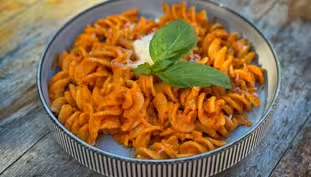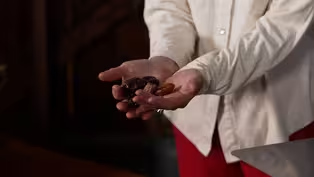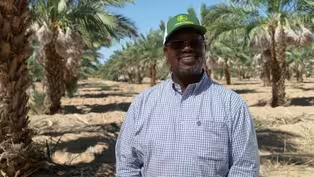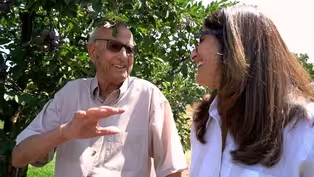
Food Literacy Center
Clip: 8/2/2024 | 4m 37sVideo has Closed Captions
Visit a cooking school and farm for elementary school students.
Visit a cooking class for elementary school students that teaches them how to properly slice, mix, prepare and enjoy farm-fresh vegetables.
Problems playing video? | Closed Captioning Feedback
Problems playing video? | Closed Captioning Feedback
America's Heartland is presented by your local public television station.
Funding for America’s Heartland is provided by US Soy, Sustainable Agriculture Research and Education, Rural Development Partners, and a Specialty Crop Grant from the California Department of Food and Agriculture.

Food Literacy Center
Clip: 8/2/2024 | 4m 37sVideo has Closed Captions
Visit a cooking class for elementary school students that teaches them how to properly slice, mix, prepare and enjoy farm-fresh vegetables.
Problems playing video? | Closed Captioning Feedback
How to Watch America's Heartland
America's Heartland is available to stream on pbs.org and the free PBS App, available on iPhone, Apple TV, Android TV, Android smartphones, Amazon Fire TV, Amazon Fire Tablet, Roku, Samsung Smart TV, and Vizio.
Providing Support for PBS.org
Learn Moreabout PBS online sponsorship♪♪♪ [ Students chatter ] Amber: I think we have an attitude in this country that if we want kids to feel special, we'll give them a treat.
Well, if you want kids to feel special and all they get is treats all the time, they're actually going to feel very special when you come and show up and give them a fruit or vegetable because you're adding something to their life that they don't often get.
Narr: Amber Stott has been on a mission to get kids to eat their fruits and veggies for more than a dozen years.
She's the founder of a nonprofit called the Food Literacy Center.
They run afterschool programs in several Sacramento schools showing students how to prepare healthy meals.
Amber: Kids want to eat fruits and vegetables.
The kids actually tell us that they know we care about them because who shows up?
What crazy people come in and say, “yay!
we're here to eat broccoli!” And because that's our message, it comes across, as we care.
Narr: Sacramento City Unified School District was so enthusiastic about this message that when an opportunity came up to turn vacant land into a farm, they turned to the Food Literacy Center.
Amber: And they asked if we'd be willing to run a farm.
And I said, “Well, if we had a farm, there would be vegetables being grown.
And we really want people to know what to do with those vegetables.
So it really does need a cooking school on site.
Fast forward many years, a lot of meetings and a lot of planning.
This site is an example of government gone right?
Narr: The one acre farm is still taking shape, but once it's completed, it will double as a public park.
There's another half acre community garden in front and inside a brand new cooking school where students from Sacramento City Unified can come for field trips.
Teacher: And that's all of your ingredients.
And then you'll make it in the bowl too.
Narr: On this day, students on a field trip from Ethel Baker Elementary School are learning how to make veggie tostadas served with fruit flavored water.
Evelyn: Students here, they build not only cooking skills and nutrition knowledge, but also resiliency and confidence when it comes to being able to make a healthy meal on their own.
When we give our students kidsafe knives and graters and cutting mats, for some of them this is the first time they've been able to use a knife and learn how to use it safely.
Narr: The mission of the Food Literacy Center ties in directly to Sacramento City Unified's goal of improving nutrition for its 40,000 plus students.
The district's new Central Kitchen opened in 2022, where meals are cooked from scratch and fruits and vegetables are sourced from local farms.
Diana: And we have seen a lot of students just throwing away all the fresh fruits and vegetables that we had sourced locally from local farmers, all the effort that we put into this produce.
But then it would go in the trash.
And so our goals are to align with the goals of food literacy center to get the kids to eat their vegetables and fruit.
Narr: Then the district found something interesting in the schools where students had been exposed to the Food Literacy Center's programs.
The students were more likely to pick healthy options.
Diana: Those students come through the lunch line and they will try nearly anything that we serve, even if they're not sure what it is, they will try it and often they will like it.
Amber: Sacramento is 1,000% one of the leaders probably in the nation of what they're doing with school lunch.
And part of that is because of our unique situation of being an America's farm to fork capital.
And part of that is the leadership of the nutrition services program here.
This model, to our knowledge, hasn't been done in other districts.
And so it's our opportunity to gather the data and show that this really works.
Narr: Sure, you could collect data or you could just pull up a seat at one of the picnic tables here.
Dig in and join the students eating veggie tostadas topped with tomato lime brown rice, cabbage, jalapeno slaw and pickled onions.
Evelyn: I love this job because I see it work every week.
I see kids try a new fruit or vegetable every week, and I see kids buying joy and making a new recipe.
Bell Pepper Pasta – Farm to Fork with Sharon Profis
Video has Closed Captions
Clip: 8/2/2024 | 5m 24s | Learn how to cook a spicy roasted red bell pepper pasta. (5m 24s)
Video has Closed Captions
Clip: 8/2/2024 | 2m 36s | Our nutrition expert looks at the sugar content of dates, and why they are a sweet treat. (2m 36s)
Video has Closed Captions
Clip: 8/2/2024 | 4m 54s | Meet a farmer growing dates he calls “Black Gold.” (4m 54s)
Video has Closed Captions
Clip: 8/2/2024 | 5m 52s | A family originally from India pass their prune orchard onto their daughters in Northern California. (5m 52s)
Providing Support for PBS.org
Learn Moreabout PBS online sponsorship
- Food
Lidia Celebrates America
Lidia Bastianich honors America’s volunteers, revealing how giving back unites and uplifts.













Support for PBS provided by:
America's Heartland is presented by your local public television station.
Funding for America’s Heartland is provided by US Soy, Sustainable Agriculture Research and Education, Rural Development Partners, and a Specialty Crop Grant from the California Department of Food and Agriculture.




